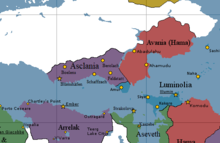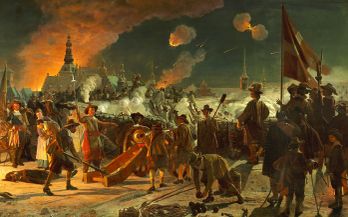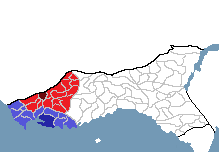Nation/Asclania
| Kingdom of Asclania Königresch Askletische
|
|||||
|---|---|---|---|---|---|
|
|||||
| Motto: "Gemeinstahm stetchen wür, vereint bleifén wür." "United we stand, united we stay." |
|||||
| Anthem: "Glory to the Kingdom of Asclania" | |||||
Asclania located on the continent of Borea
|
|||||
| Region | The East Pacific | ||||
| Capital and largest city | Blümshäfen | ||||
| Official languages | Aüssneré | ||||
| Recognised national languages | German, French | ||||
| Demonym | Asclanian | ||||
| Government | Semi-parliamentary Monarchy | ||||
| - | King | Frederick von Edichzollern II | |||
| - | Queen-consort | Erika von Edichzollern | |||
| - | Prime Minister | Louis Erideu | |||
| - | Upper house | Senate | |||
| - | Lower house | Royal Convention | |||
| History | |||||
| - | Founding | 1721 | |||
| - | Asclanian Consolidation | 1786 | |||
| - | Asclanian Civil War | 1842 | |||
| - | First Asclanian Constitutional Revision | 1853 | |||
| - | Asclanian Economic Recession | 1911 | |||
| - | Second Asclanian Constitutional Revision | 1932 | |||
| Population | |||||
| - | 2016 estimate | 68,906,192 | |||
| - | Density | 176/km2 455.8/sq mi |
|||
| Gini (2014) | 0.237 low |
||||
| HDI (2014) | 0.9478 very high |
||||
| Currency | Asclanian Klevenar (Ӄ) [AKR] (t) |
||||
| Time zone | Asclanian Time Zone (UTC+2 to +8) | ||||
| Date format | dd ˘ mm ˘ yyyy | ||||
| Internet TLD | .ask, .asl, .cis, .can, .sim | ||||
Asclania, (Asklecheré: Das Königresch Askletische), is a Semi-parliamentary Monarchy in Borea. The country resides inside of The East Pacific, occupying a large portion of the Asclanian valley. With a fairly small size and a partially limited economy, Asclania is not considered a power in even Borea. The nation is almost entirely comprised of Asclanians, with small migrant populations, despite the nation having restrictive immigration policies.
Large amounts of non-Asclanian populations were purged in the Asclanian Middle Ages, which led to most of the ethnic purity in the region, as well as giving the Last Duke of Blümshäfen, Duke Fritz von Edichzollern, reason for invading the rest of the duchies and fiefdoms that comprised the Asclanian Territory, the pre-unified complex body of countries that dominated the region prior to the Asclanian Unification. In 1721, after the Siege of Berolach, the remaining 16 Coalition Members signed the Treaty of the Council, ending the war and ratifying the Council of Aggenpraz's ruling, bringing an end to the war. In 1839, the Asclanian Royal Convention reviewed the ruling of the Council of Aggenpraz, and deemed it illegal, starting the Asclanian Civil War. Afterwards, the King revised the Constitution in 1853, effectively turning the Convention into an advisory board. The Asclanian Economic Recession in 1911 led to nationwide food shortages and severe unemployment, causing hyper-inflation of currency and almost setting the country into a second civil war, but eventually recovered. In 1932, when the recession was deemed to be over, the King again revised the constitution, creating a new legislative body, the Senate, which consisted of commission-paying members of the Royal Convention, with the senate being given the only official legislative power, albeit very limited.
Contents
Etymology
The English word Asclania was created by a game of linguistic telephone from the Aüssneré word, Askletische, which came from the Old Aüssneré word Atklerichtschten, meaning "The Region of Asclania". Although the true origin of the language is not entirely known, as it was never recorded, it is expected to have formed somewhere in north-western Borea, and slowly migrated down the coast as the Asclanian people settled and founded their cities.
History
Asclanian Tribes and Migration
Asclanians are a subset of Germanic tribes that originated on Borea some several hundred thousand years ago. Although Germanic peoples can be found in Asclania and Borea today, there were no other traces of Germanic cultures nor language other than Asclanian for thousands of years of recorded Asclanian history, suggesting some sort of mass migration by the Asclanian peoples. Although many tribes at first were distinct from each other, as they began to interact and discuss, they began to form a blend of culture, which still to this day has more or less only seen a few major transitions.
Asclanian Confederation and War
As tribes began to communicate and interact, many of them began to form a group of nations, known as the Asclanian Confederation, which laid the groundwork for the formation of the Kingdom of Asclania later on, which at its strongest position, comprised of over 600 duchies, fiefdoms, and margraviates, each of which answered to the Confederate Head, the electoral leadership position of the Confederation. Although wars were technically outlawed by the Convention of 1142, nations still fought over territory and political dominance, many of which went unpunished by the Confederation's Justiciars.
By 1527, the Confederate influence over many nations was beginning to slip, causing many nations to seek association with a second growing political entity, the Blümshäfen-Boelen Entente, which had opposed the Confederation from its conception early on. Seeing this, in 1533, the Confederate Head, the Duke of Feldstatt ordered that the Blümshäfen-Boelen Entente was to be dissolved, or the states inside were to be removed from the Confederation. Despite many leaving, the Duke of Blümshäfen issued his own decree, stating that the Confederation was invalid and should allow states to come and go as they pleased, sparking the Asclanian Wars of Confederate Dissolution.
The first battle of the war, the Battle of Mühlberg, was initiated by Duke Paulus of Tanburg, fielding the Entente's main field army against the Confederate Army, led by the Duke Frederick of Feldstatt. Lasting almost a full week and a half, the battle cost both sides around twenty-two thousand casualties each, and over ten thousand were missing and never recovered. Despite heavy losses, Entente forces managed to push back the Confederate troops, giving them a clear path at the city of Feldbühel, a large industrial center which had not yet sided with either the Entente or the Confederacy.
The Asclanian Confederation held out a defence at Feldstatt in 1556, with an almost year-long siege that killed almost half the population of the major city. The battle resulted in the surrender of Duke Frederick, the capturing of a river-crossing into the rest of the countryside, which would allow Entente armies to move freely, and plenty of food supplies left-over. Seeing this, the remaining dukes surrendered their forces, ending the War, which lasted twenty-three years, and destroyed much of the territory.
Following the war, the Asclanian Confederation was dissolved by the victorious Entente, and then dissolved the Entente, allowing for nations to determine their own laws and not have to worry about intervention in their wars. This also brought with it a major restructuring of the territories, with many Duchies and Fiefdoms being destroyed and annexed, as well as the enactment of the Invernachtionalern Friseichtzungbeschlung (International Freedom Decree), which abolished serfdom and slavery.
Asclanian Unification and Kingdom
With the Asclanian Countryside ravaged by war, the Entente gone, and the Asclanian Confederacy dissolved, Asclania was an increasingly complex area of warring states and duchies that answered to almost nobody. Many of the stronger powers in the region, primarily the Duchy of Blümshäfen, began to take note of the states that were slowly allying with stronger powers. However, others did as well, noticing that Blümshäfen was quickly becoming a competitor for power, and once again, there were large alliances in Asclania.
In 1592, Duke Erich von Edichzollern of the Duchy of Blümshäfen enacted the Lokale Herdschafter Leeren (Local Dominion Doctrine), which established Blümshäfen as the sole protector of nearby states, essentially turning them into Blümshäfen territory. This marked the first annexation of an entire country since the Asclanian Wars of Confederate Dissolution, shocking many of the Dukes who then realized their territories may be at stake. A further wedge was driven between Blümshäfen and the rest of the Asclanian territories was their often hostile attitude towards those that didn't align with Blümshäfen, which thought itself to be the strongest power over the rest. This idea was partially true, mainly due to the fact that Blümshäfen soldiers were trained better than that of the other, larger duchies.
This rift opened up, when, in 1598, Blümshäfen troops entered into the Duchy of Holberg, a Boelens-aligned nation. Boelens responded with an ultimatum, demanding that they leave the territory, or they would declare war. Blümshäfen did not answer them, and continued in, resulting in the First Asclanian Coalition Against Blümshäfen (Also known as the First Coalition War), which resulted in a Blümshäfen victory, and caused the Duchy of Boelens to be removed from the map, and turned the rest of the Asclanian territories against them.
Although all territories fought in the war at some point, the Anti-Blümshäfen Coalition suffered from the fact that not all of the Duchies joined at the start, lowering their ability to defeat the ever-growing Blümshäfen Alliance forces, meaning easier unification for them. By 1721, Blümshäfen forces had captured the last Coalition City was captured, Dunburg, and convened the Council of Aagenpraz, ending the Coalition Wars and unifying the Asclanian territories under the Blümshäfen banner.
After the War and Consolidation
Asclania suffered from massive damages to its countryside and infrastructure after the war, which after it was over, was a priority for the government to repair. To remedy this, the government proposed the Zentrichisierendungsdelkrent, which would release a portion of territories on the boundary of the new nation so the rest of the country was easier to manage. It was passed in 1727, and the changes significantly helped the national effort to repair the country. A Blümshäfen-dominated Asclania brought a unified Asclanian language, a set of official laws, and universal monetary system. They built schools, brought industrialization to the less-advanced sections of Asclania, developed the cities, created a navy, national police, and made all members register a last name with the government.





